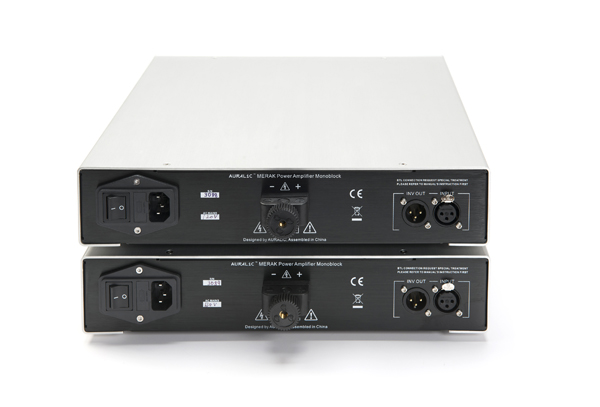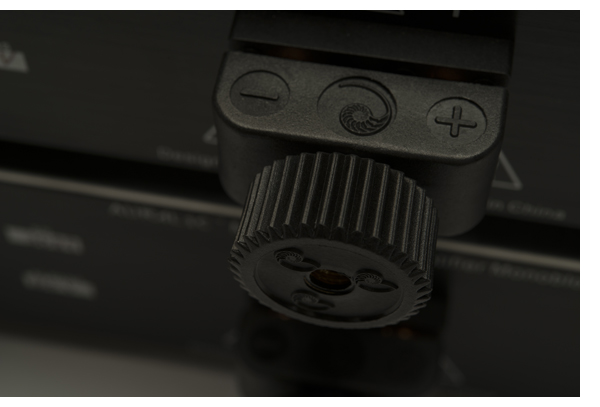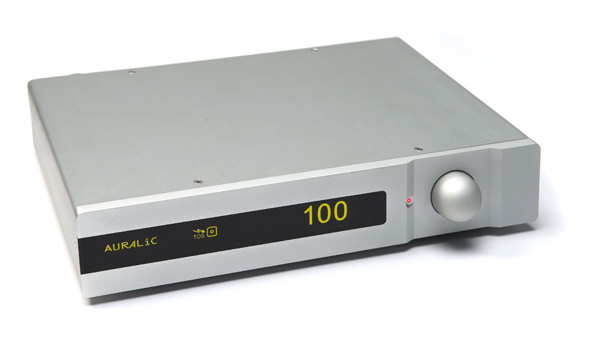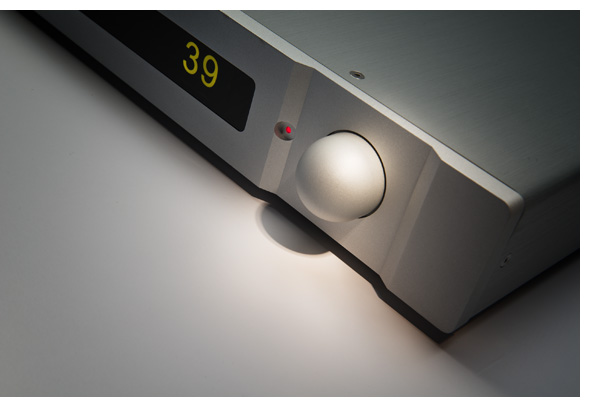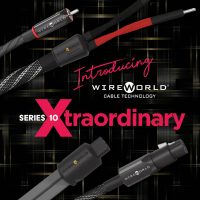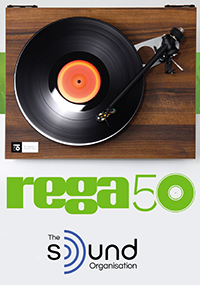China’s AURALiC, a relative newcomer to the hi-fi industry, has stepped into this crowded scene with some quality products, and the company sets a high bar for itself with each new release. Seeing AURALiC’s new MERAK monoblocks (priced at $5,000 per pair) freshly out of their packaging is a bit like seeing a great tuxedo-wearing magician backstage before a much-anticipated performance. It’s easy to admire the polished outward appearance, but as anticipation begin to grow, it becomes clear that something interesting will happen when the curtain rises, leaving one to wonder if the performance will live up to expectations.
Smoke and Mirrors?
In every way, these amps offer substantial build quality and beautiful fit and finish. The sleek, brushed metal exteriors of my test pair sport a matte-silver finish—but the modest exterior does not reveal what’s hidden beneath the handkerchief. These mono monsters offer 400 watts of juice into 4 ohms and half of that into 8 ohms. According to AURALiC, the MERAKS’ capacitors hold enough energy to deliver 16 amps of peak current and 900 watts of power. By comparison, my reference amp—a Mark Levinson 335 stereo amp—pushes 500 watts into 4 ohms. From a power perspective, I never feel that my power-hungry Piega P10 speakers are limited with the Meraks in the chain.
Not a full Class D design, AURALiC refers to the MERAK as a hybrid design using Class-A signal amplification, switching output stage and linear power supply, sounding surprisingly like another very exciting amplifier that graced our cover a couple of years ago. In daily use, these monos never get hot, even when they are powered up for a couple weeks continuously. In addition to the stellar energy efficiency of the MERAKs, their design allows the user to stack them in an audio shelf without worry of overheating. Each amp measures 11 inches wide, 11 inches deep, and 2.75 inches high, so even in a two-tier configuration the amps’ physical footprint remains modest.
By sharp contrast, moving my Mark Levinson 335 stereo amp (which should have come with a coupon for a hernia operation) requires a friend, or a couple post-move aspirin. The MERAKs, which weigh 18.7 pound apiece, are extremely easy to carry by comparison. In fact, I’m able to carry one amp under each arm and still have a spring in my step.
Sleight of Hand
Connecting the amps is as simple as expected. I must give AURALiC kudos for including Cardas CE binding posts with the amps. Clamping a single knob down onto a tough plastic bracket holds my speaker cable’s spade terminations against the posts. And it’s so easy to get a good finger hold on the knob that I don’t need a post wrench (or a kung-fu grip) to get a tight cable connection. I should note that this knob-bracket combo does not accommodate banana cable terminations.
The MERAK s offer only balanced XLR inputs, and so given my single-ended preamp, I choose to enlist the help of some adapters. After contacting AURALiC to see if they have any specific recommendations for or against that approach, I get the thumbs-up for adapters, which do the trick. After testing them with my Levinson to ensue they don’t color or cloud the sound to any significant degree, the adaptors are easy enough to drop in place. Once flicking the rear switch to activate the amp, pressing a small button on the front puts them in and out of standby mode, which a small LED indicates.
Firing up the MERAKs without source material playing, I’m amazed by their silence. If it weren’t for the LED indicator, I’d wonder if they were powered up at all. With the rest of my audio chain shut down, only the ribbon tweeter of my Piegas can reveal any audible hiss—and only when I put my ear against it. I leave the amps on for two weeks straight for both burn-in and stress testing and I never experience anything from my listening position except great music. That’s a disappearing act indeed!
Rabbit from a Hat
Switching designs inherently bring a lot of positive merits. First, their power-to-weight ratio offers very good value for the dollar. They also sip energy (rather than gulping it), which makes them the more environmentally friendly option. These amplifiers have come a long way in the last few years, but I generally find them lacking some of the subtle detail, frequency extension, and sonic emotion I’m accustomed to with class-A or AB designs. But contrary to my assumed impressions, the MERAKs provide some very welcome surprises that challenge my past views in meaningful ways.
During my first listening session, covering about 20 tracks of various music types, several characteristics stand out immediately. The MERAKs do not romanticize the sound, nor do they leave it overly stark and cold. They strike the right balance. They also do a very nice job of creating the ambience and reverberation around the musicians.
Also impressive is the soundstage they throw, which is both wide and tall. There are no perceived boundaries and the sound extends well beyond the speakers. Additionally, they do a very good job of layering instruments in depth. Music reveals itself both in front of and behind the plane of the speakers. Vocals stand out front and the other instruments fall into their proper alignment behind the vocalist. This characteristic is one of the MERAKs strengths and it’s very engaging with all types of music. Few tracks illustrate this better than Portishead’s Roseland NYC Live on vinyl. When delivering the track “Roads,” the MERAKs pull Beth Gibbons’ voice out front such that the illusion of the singer extends into the room and creates an appropriately upfront but unaggressive presentation. There’s no stridency, and vocals retain the engagement they should command. The MERAKs also place the sound of the crowd clapping along well into the background.
Enya’s album Watermark does present two noticeable downsides that my Levinson does not. First, with all the juice that the MERAKs bring, they most definitely take control of the speakers and maintain a tight command, which results in the bass losing a bit of low-frequency punch and definition and the highs losing a bit of sparkle. Secondly (and more subjectively), there’s a reduction in the underlying emotion of the song.
It’s hard to put a finger on this at first, but after listening to several tracks on various albums—both digital and vinyl—I notice a consistent signature to the MERAKs. There’s a slight veil, which results in the reduction of the nuanced detail and delicacy that gives increased realism to good recordings. Of course, this quibble is in comparison to an amplifier priced around $8,000, yet the Meraks run for only $5,000 a pair. At that price difference, I’d expect the Levinson’s performance to exceed the MERAKs’ by a significant margin.
Abracadabra!
Delivering the disco-y tunes Daft Punk’s Random Access Memories, proves to be a joy, with a very nice integration of instrumentation, and the perceived pacing of the music brings a captivating energy to the recording. A remastered Royal Edition recording of Mozart’s symphony No. 36 performed by Leonard Bernstein and the New York Philharmonic also illustrates the MERAKs’ prowess with wide dynamic swings.
Pink Martini’s “Omide Zendegani,” and other tracks from Get Happy, similarly reveals an ability to pristinely render more intimate songs with a small combination of vocals and instruments. But, where necessary, the amps are also able to decipher a complex array of instruments across the soundstage.
Take a Bow
As with a great magician, it’s hard not to be impressed with MERAKs’ capabilities and finesse. Of the class-D designs I have experienced so far, these top my list sonically – I’m sure the hybrid design contributes to this sense of ease in a big way. Compared to my favorite class-A and class-AB amps, the MERAKs have only a few tradeoffs, as noted above. At the same time, there is a lot to love—and kudos again to AURALiC for taking switching amplifier design further toward an elusive sonic pinnacle than my past experiences. Even when mated with very revealing and power-hungry speakers, the MERAKs never take the sound into the realm of stridency, and considering their other merits, it’s easy to settle in for a long listening session of great music.
While $5,000 is a significant financial commitment for most people, what you get with these amps represents great value in terms of watt-per-dollar ratio. There are many good amps in this price range, so the MERAKs face some stiff competition—but with oodles of power and very good sonics, these amps are certainly worth your consideration.
Additional Listening
The folks at AURALiC are on a roll. We’ve had the pleasure of listening to almost their full line now, and they all share an equal level of sonic excellence, build quality and elegant visual understatement. Best of all, the gear is reasonably priced, over delivering for the prices asked. This just might be the next big brand in world of hifi, no small achievement.
I concur with Rob on all of his observations, and feel that the MERAKs strike a fantastic balance of timbral and tonal accuracy, major dynamic slam and a complete lack of fatigue. Putting them through their paces with the KEF Blades, the Focal Maestro Utopias and the Dynaudio Evidence Platinum speakers proved the $5,000 pair of AURALiC amplifiers were not out of place in a six figure system.
However, like every other switching amplifier I’ve had in the listening room, the MERAKs benefit from careful attention to what’s coming from the AC line. While they offer great sonics just plugged into the wall, a top notch power line conditioner will take them to an even further level of clarity. And, should you need a bit of warmth in the mix, you can always pair these amplifiers with your favorite vacuum tube preamplifier.
In short, the AURALiC MERAK amplifiers offer tremendous sound for a very reasonable price. We look forward to see what they will come up with next. Maybe a 250 watt per channel stereo amplifier in one box? Hmmm.
MERAK monoblock amplifiers
MSRP: $5,000 per pair
PERIPHERALS
Speakers
Piega P10
Amplifier
Mark Levinson No. 335
Preamplifier
Coffman Labs G1-A
Digital Sources
Audio Research CD3 MKII Light Harmonic DaVinci DAC HP 2.5 GHz Quad Core running Windows 7 and JRiver Media Center 19.0.32
Analog Source
Marantz TT-15 turntable with Clearaudio Virtuoso cartridge
Cables
Jena Labs Valkyrie and Symphony interconnects Jena Labs Twin 15 speaker cables
Power
Running Springs Audio Haley power conditioner Cardas Golden and Golden Reference/Mongoose power cords
Accessories
Mapleshade SAMSON racks and shelves ASC TubeTraps Cathedral Sound room-dampening panels Coffman Labs equipment footers





